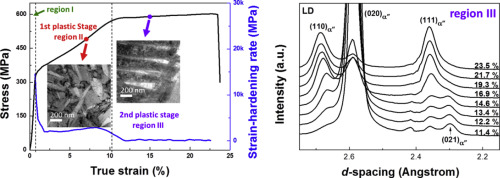当前位置:
X-MOL 学术
›
Acta Mater.
›
论文详情
Our official English website, www.x-mol.net, welcomes your feedback! (Note: you will need to create a separate account there.)
In situ synchrotron X-ray diffraction investigations of the physical mechanism of ultra-low strain hardening in Ti-30Zr-10Nb alloy
Acta Materialia ( IF 9.4 ) Pub Date : 2018-08-01 , DOI: 10.1016/j.actamat.2018.05.034 Z.W. Zhu , C.Y. Xiong , J. Wang , R.G. Li , Y. Ren , Y.D. Wang , Y. Li
Acta Materialia ( IF 9.4 ) Pub Date : 2018-08-01 , DOI: 10.1016/j.actamat.2018.05.034 Z.W. Zhu , C.Y. Xiong , J. Wang , R.G. Li , Y. Ren , Y.D. Wang , Y. Li

|
Abstract A warm-rolled, metastable β-type Ti-30Zr-10Nb alloy exhibited a peculiar two-stage yielding behavior under uniaxial tensile loading, showing a first plastic stage with obvious strain hardening at 0.4%–10.4% strain and a second plastic stage with ultra-low strain hardening at 10.4%–23.5% strain. In situ high-energy X-ray diffraction (HE-XRD) was used to reveal the stress-induced martensitic transformation scenarios and physical mechanism of the different strain hardening rates. It was found that the deformation-induced phase transformation dominated the onset of the first plastic stage corresponding to the selection of favorable martensitic variants, and their elastic interaction contributed to the obvious strain hardening. HE-XRD experiments further verified that the ultra-low strain hardening rate in the second plastic stage was related to an interesting superelasticity of the martensite, which was characterized by the reversible, stress-induced reorientation of the martensite variants. This reorientation of the martensite variants was primarily due to the rigid lattice rotation of ∼23° about the [110]α″ axis toward the tensile direction. Our investigations provide in-depth understanding of the mechanism of the excellent plasticity with ultra-low strain hardening in β-type titanium alloys.
中文翻译:

Ti-30Zr-10Nb合金超低应变硬化物理机制的原位同步辐射X射线衍射研究
摘要 一种热轧亚稳态 β 型 Ti-30Zr-10Nb 合金在单轴拉伸载荷下表现出独特的两阶段屈服行为,显示出第一塑性阶段在 0.4%–10.4% 应变下出现明显的应变硬化和第二塑性阶段具有 10.4%–23.5% 应变的超低应变硬化。原位高能 X 射线衍射 (HE-XRD) 用于揭示不同应变硬化速率的应力诱导马氏体转变场景和物理机制。发现变形诱导相变主导了第一塑性阶段的开始,对应于有利的马氏体变体的选择,并且它们的弹性相互作用促成了明显的应变硬化。HE-XRD 实验进一步证实,第二塑性阶段的超低应变硬化率与马氏体有趣的超弹性有关,其特征是马氏体变体的可逆应力诱导重新取向。马氏体变体的这种重新定向主要是由于围绕 [110]α'' 轴朝向拉伸方向的刚性晶格旋转约 23°。我们的研究深入了解了 β 型钛合金具有超低应变硬化的优异塑性的机制。马氏体变体的这种重新定向主要是由于围绕 [110]α'' 轴朝向拉伸方向的刚性晶格旋转约 23°。我们的研究深入了解了 β 型钛合金具有超低应变硬化的优异塑性的机制。马氏体变体的这种重新定向主要是由于围绕 [110]α'' 轴朝向拉伸方向的刚性晶格旋转约 23°。我们的研究深入了解了 β 型钛合金具有超低应变硬化的优异塑性的机制。
更新日期:2018-08-01
中文翻译:

Ti-30Zr-10Nb合金超低应变硬化物理机制的原位同步辐射X射线衍射研究
摘要 一种热轧亚稳态 β 型 Ti-30Zr-10Nb 合金在单轴拉伸载荷下表现出独特的两阶段屈服行为,显示出第一塑性阶段在 0.4%–10.4% 应变下出现明显的应变硬化和第二塑性阶段具有 10.4%–23.5% 应变的超低应变硬化。原位高能 X 射线衍射 (HE-XRD) 用于揭示不同应变硬化速率的应力诱导马氏体转变场景和物理机制。发现变形诱导相变主导了第一塑性阶段的开始,对应于有利的马氏体变体的选择,并且它们的弹性相互作用促成了明显的应变硬化。HE-XRD 实验进一步证实,第二塑性阶段的超低应变硬化率与马氏体有趣的超弹性有关,其特征是马氏体变体的可逆应力诱导重新取向。马氏体变体的这种重新定向主要是由于围绕 [110]α'' 轴朝向拉伸方向的刚性晶格旋转约 23°。我们的研究深入了解了 β 型钛合金具有超低应变硬化的优异塑性的机制。马氏体变体的这种重新定向主要是由于围绕 [110]α'' 轴朝向拉伸方向的刚性晶格旋转约 23°。我们的研究深入了解了 β 型钛合金具有超低应变硬化的优异塑性的机制。马氏体变体的这种重新定向主要是由于围绕 [110]α'' 轴朝向拉伸方向的刚性晶格旋转约 23°。我们的研究深入了解了 β 型钛合金具有超低应变硬化的优异塑性的机制。



























 京公网安备 11010802027423号
京公网安备 11010802027423号